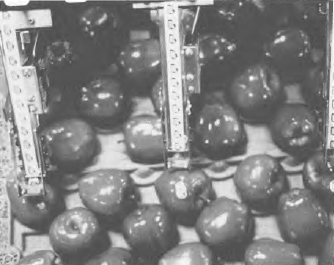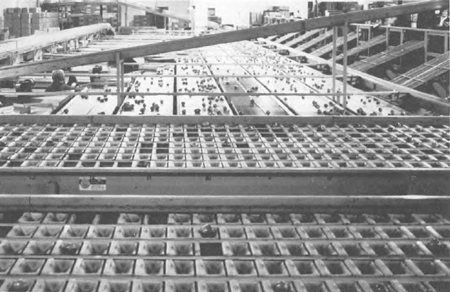News & Events More |
Chronicle: 1984
The total [tree fruit] industry debt is estimated at more than $200 million-producers owe $150 million to chartered banks and $36 million to the federal Farm Credit Corporation. The ten packing houses and two grower-owned firms owe $35 million. (Malcolm Turnbull in Country Life in British Columbia.)
Vignette: Amalgamation Leading to the Formation of B.C. Fruit Packers in 1983 by John Duncan (President, B.C. Fruit Packers, since 1986)Consolidation of packinghouses is not a new concept in the B.C. fruit industry. Records can be found as far back as 1923 when directors of the newly founded Naramata Co-operative discussed acquiring the assets of the Summerland Fruit Union. The result of these discussions, however, was the purchase of a typewriter when the assets of the Summerland organization were liquidated! The Penticton growers' first serious attempt at packinghouse merger came after the MacPhee Report was released. John Coe of the Penticton Co-operative initiated talks with the Kaleden Co-operative, United Co-op, Naramata Co-op, and the Pyramid Cooperative, during the early and mid 1950s, with the thought of building a central packinghouse at Penticton. No merger resulted and the Penticton Cooperative built a new, modern packing plant hoping to attract a merger at a later date. The freeze of 1965 resulted in a severe loss of tonnage. The Penticton Co-operative went bankrupt. The growers from this organization were taken in by Naramata and the Pyramid of Penticton. By 1971, the Pyramid Co-operative had more tonnage than it could store, so again talks were initiated by John Duncan of the Pyramid Cooperative, Walter Powell of the Summerland Cooperative and Bill June of the Naramata Cooperative. As a result, the Pyramid and Summerland Co-operative merged to form the Lake Area Co-operative in 1973. Early in 1974, Gerry Bowering of the Lake Area Co-operative asked his Directors to commission the B.C. Research Council to undertake a study of a centralized pre-grade operation for the Lake area, including Naramata and Westbank Cooperatives. The study concluded that a pre-grade installation for the area would be desirable and economical, with savings of $8.00 per ton projected. This was a substantial saving when wages in the packinghouses were $2.30 for women and $3.21 for men. No merger resulted. In 1976, the Kelowna Growers Exchange, Cascade Co-operative, and O.K. Packers were concerned about the risk of putting in new packing technology and yet realized the need to modernize their plants. Therefore, late in 1976, the largest merger ever to take place occurred, creating Kelowna Growers Co-operative. In 1978 a more detailed study was carried out by Food Plant Engineering on the savings of a merger of Naramata and Lake Area Co-operative and the installation of a pre-grade, pre-size operation. In January, 1979, the members of Lake Area Co-operative and Naramata Co-operative voted on the merger, but Naramata defeated the resolution by four votes. The tree fruit industry generated poor returns for the growers in the early 1980s. As a result, growers and packinghouses were under severe pressure to reduce costs. While there was some success, it was not enough to provide the growers with adequate returns. The B.C.F.G.A. had commissioned a study by Roygold Marketing to look at the industry and identify other opportunities for improving grower returns. This report was presented in March, 1983, and recommended total integration of all packinghouses and B.C. Tree Fruits. Improved returns of $14 million were identified in this report. In April, 1983, the K.G.C. Board met with all packinghouses from Vernon to Osoyoos. From these meetings K.G.C., Vernon Fruit Union, and Lake Area Co-operative formed a committee of six to explore the possible merger of the three organizations: Ernie Malen and Louis Rampone (Kelowna Growers Co-operative), Max Day and Jamie Kidston (Vernon Fruit Union), and John Duncan and Karl Seidel (Lake Area Co-operative). Meetings were held by this committee and the managers of the three co-ops: Richard King (Kelowna Growers Co-operative), Bill Smith (Vernon Fruit Union), and Moe Lidster (Lake Area Co-operative). It was found that savings of well over one million dollars were possible with the merger of the three packinghouse organizations. 
On May 2, 1983, Richard Bullock, President of the B.C.F.G.A., chaired a meeting of the Packinghouse committee to work out the details of amalgamation. A second meeting on May 12, 1983, finalized the report to the three packinghouse Boards and worked out the terms for the merger of Vernon Fruit Union, Kelowna Growers Cooperative, and Lake Area Co-operative. The three Boards voted unanimously to accept the recommendation of the committee to proceed with amalgamation of the packinghouses and to hold meetings with the growers. Under the Provincial Co-op Act, 75 per cent of members were required to vote in favor of the special resolution to merge. The stage was set and meetings were called. The resolution was worded in such a way that any two could merge. Vernon Fruit Union voted on three different occasions and defeated the resolution each time. After much debate, the third vote on December 13 was close, with 83 voting yes and 30 no: 74 per cent. The resolution was lost by two votes. The directors of all three organizations were in shock. The next day, December 14, the Kelowna meeting was held at the Capri Hotel, where Peter Stirling presented the resolution on behalf of the K.G.C. Board and Richard King, manager, spoke at length about merger between two packinghouses and how it would work. The vote looked like it might be close, until Suey Koga (a Director of K.G.C.) made a speech asking for trust and reason. This made the difference and the K.G.C. voted 78 per cent in favor of merger. The next day, December 15, 1983, Lake Area Co-operative held its meeting at the Summerland Rec. Centre. John Duncan presented the resolution on behalf of the Board, to the 80 growers present. The vote after about two hours of discussion was 74 yes, 6 no: 92 per cent in favor. So on the afternoon of December 15, 1983, B.C. Fruit Packers was born. It serves growers from Okanagan Falls to Winfield and handles 45 percent of the fruit growers in the Okanagan Valley. Contact Us Hours: 9am - 4pm weekdays. t: 250-762-5226 |

